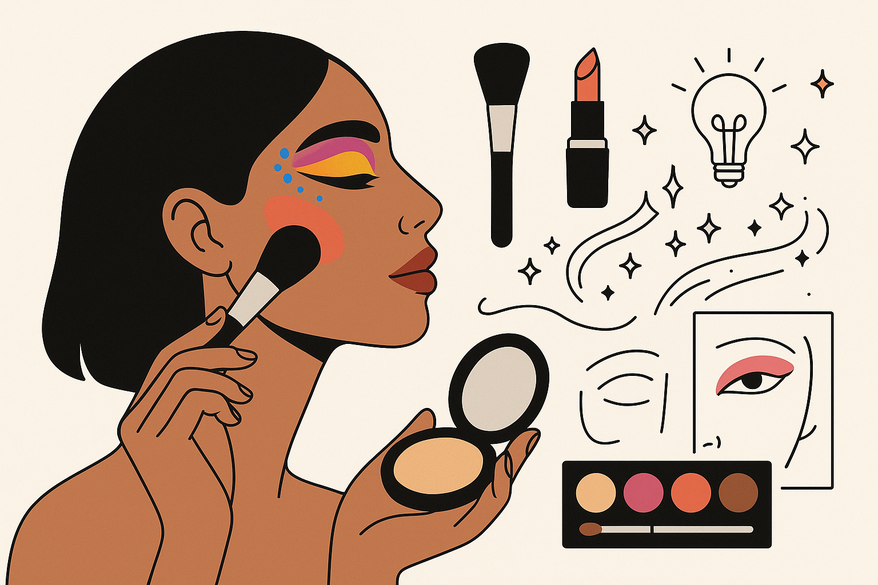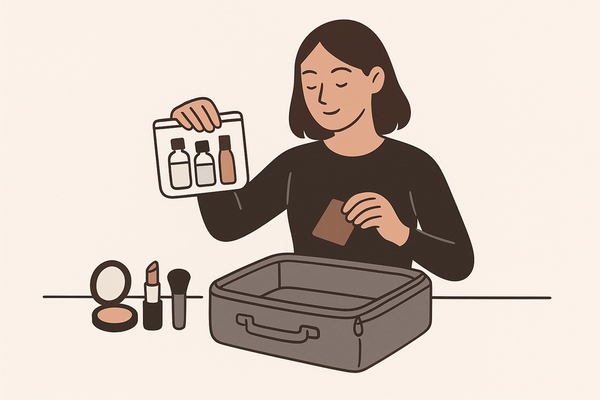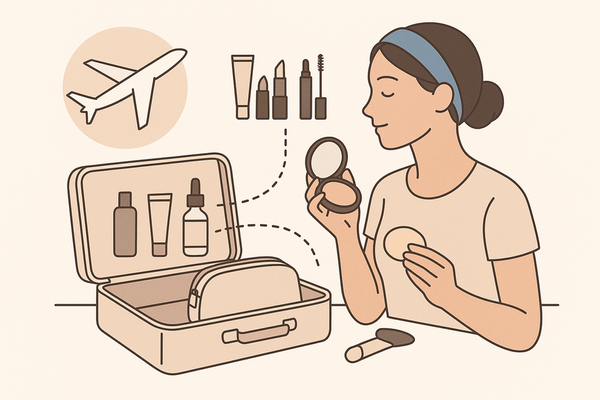10 Inspiring Creative Makeup Designs to Elevate Your Artistry
Explore inspiring creative makeup designs that elevate artistry with unique techniques and trends. Discover tips and tools for standout looks.

Estimated reading time: 10 min read
Key Takeaways
- Historical evolution: From Ancient Egypt’s kohl to today’s HD pigments, creative makeup has transformed across cultures and eras.
- Four signature styles: Avant-garde, fantasy, editorial, and special effects each offer unique artistic avenues.
- Essential techniques & tools: Master blending, graphic liners, 3D embellishments, and rely on high-pigment palettes and medical-grade adhesives.
- Step-by-step workflow: Prep skin, map your design, build color, add details, then set and finish for long-lasting impact.
- Expert insights: Focus on a focal point, mood-board broadly, and engage with emerging talent to stay inspired.
- Dos & don’ts: Patch-test products, photograph in natural light, sanitize tools—and avoid heavy layers or skipping removal routines.
Table of Contents
- Introduction & Media Showcase
- Background and Evolution
- Categories of Styles
- Techniques & Tools
- Step-by-Step Guide
- Expert Insights & Inspiration
- Dos and Don’ts
- Conclusion & Call-to-Action
Introduction & Media Showcase
Creative makeup designs are booming as a form of bold self-expression and boundary-pushing artistry. From festival face art to ultra-realistic SFX transformations, artists are redefining beauty with high-definition cosmetics and global collaboration. As AI democratizes creativity, you can experiment using AI-powered platforms for real-time feedback and custom palettes.
Background and Evolution
Makeup has been a cultural marker for thousands of years. In Ancient Egypt, kohl-lined eyes signified status and offered sun protection. Greek and Roman civilizations used pigments for ritual and social signaling. Over the 20th century, cosmetic artistry evolved dramatically:
- Early 1900s: Subtle enhancements with limited color ranges.
- 1960s & 1980s: Bold graphic liners, bright hues, theatrical flair.
- 2000s–Present: Social sharing and HD formulas spark editorial and avant-garde trends.
Key transformations:
- SFX makeup: Prosthetics, silicone pieces, hyper-realistic wounds for film and events.
- High-definition cosmetics: Fine pigments and refined formulas for crisp lines and 3D textures on camera.
- Social-media challenges: Instagram and TikTok tutorials launch viral face-painting trends and design contests.
Milestones:
- Avant-garde looks on Paris and Milan runways.
- Fantasy makeup featured in blockbuster films and streaming series.
- Everyday creators spotlighted via hashtags and viral reels.
These developments turned creative makeup designs into a global movement—democratizing advanced techniques once limited to professionals. For more on upcoming trends, see makeup trends for 2025 and top trends in the makeup industry.
Categories of Styles
Creative makeup designs break down into four signature categories, each serving different occasions and artistic aims:
- Avant-Garde Makeup
– Abstract, conceptual artistry with sweeping lines or sculptural forms.
– Seen on high-fashion runways and editorial shoots.
– Example: Patricia Bright’s “Neon Ribbon” lash install.
For more inspiration, explore avant-garde inspiration. - Fantasy Makeup
– Mythical or supernatural motifs using bold color blends.
– Popular at festivals, cosplay conventions, and themed events.
– Example: @ArtBySandy’s Mermaid Scale look with iridescent paints. - Editorial Makeup
– Dramatic, polished storytelling for magazines and ad campaigns.
– Featured in Vogue spreads, beauty editorials, and perfume ads.
– Example: Mario Dedivanovic’s metallic cut-crease for a fashion editorial. - Special Effects (SFX) Makeup
– Realistic or fantasy transformations with prosthetics, latex, 3D textures, and blood effects.
– Used in horror films, Halloween events, and stage productions.
– Example: Rick Baker’s werewolf transformations and @Eddie_Makeup’s viral zombie tutorials.
Techniques & Tools
Mastering creative makeup requires precision techniques and reliable products:
Techniques
- Blending & Layering: Apply creams and powders from light to dark, feather edges with a damp sponge for seamless transitions.
- Highlighting & Contouring: Use shades two tones lighter/darker to sculpt cheekbones, temples, and nose bridge.
- Graphic Liners & Color Blocking: Opt for waterproof, high-pigment liners; create negative-space shapes by leaving gaps between strokes.
- 3D Embellishments: Attach glitters, rhinestones, and decals with skin-safe adhesive; layer prosthetics for realistic texture.
Tools & Products
- Brushes: Fine-tip liners, blending fluff, angled shaders.
- Sponges: Beauty blenders, silicone pads for airbrush-like finishes.
- High-pigment palettes: Brands like Mehron, Kryolan, NYX Professional.
- Adhesives: Medical-grade prosthetic glue and proper removers.
- Setting sprays & powders: Ultralight translucent powders and long-hold sprays for stage or outdoor wear.
For additional product insights, check makeup trends for 2025.
Step-by-Step Guide
- Skin Prep: Cleanse, tone, moisturize; apply a silicone-based primer for extra grip.
- Design Mapping: Sketch shapes on paper or trace lines with white eyeliner; reference mood boards.
- Base & Color Building: Lay down foundation or face paint; layer pigments from pale to vibrant.
- Detail Work: Draw graphic lines with gel liners; apply 3D elements (rhinestones, prosthetics) via dot application for precision.
- Setting & Finishing: Dust translucent powder over matte zones; mist setting spray; clean edges with a micro-sponge soaked in micellar water.
Pro Tips:
• Practice on a makeup wheel or wrist before going full-face.
• Mix textures by pairing cream paints with loose pigments.
• Photograph mistakes—then refine your approach.
Expert Insights & Inspiration
Top MUAs and industry voices share these nuggets:
- “Start with a focal point.” Choose an eye or lip highlight and build symmetry around it to anchor your design.
- “Mood-board from diverse sources.” Pull inspiration from art galleries, street fashion, flora, or architecture.
- “Engage with emerging talent.” Follow creators on Instagram and TikTok—comment, ask questions, and learn from the community.
Viral Case Studies:
– Color-blocked eyes: @JessicaVArt’s split-color lids exploded on TikTok, inspiring thousands to remix her template.
– Hyper-realistic SFX: @OliviaJ_MUA’s aging-illusion tutorial racked up millions of views.
– Negative-space florals: A North London collective painted petal gaps, showcasing texture play on Instagram Reels.
Dos and Don’ts
Dos
• Patch-test new pigments and adhesives on your inner wrist 24 hours before full application.
• Photograph in natural light to judge true color and detail.
• Sanitize brushes, sponges, and tools before and after each use.
Don’ts
• Don’t overload skin with heavy layers—opt for breathable formulas.
• Don’t skip your removal routine; use oil cleansers or silicone-safe removers for SFX residues.
• Don’t copy looks blindly—adapt shapes and shades to your facial structure and skin tone.
Conclusion & Call-to-Action
Creative makeup designs unlock limitless avenues for self-expression, turning your face into a vibrant canvas. By understanding their history, mastering essential techniques, and learning from industry experts, you’re ready to craft looks that captivate on stage or social feeds.
Follow the step-by-step guide, explore avant-garde or fantasy styles, and keep expert tips in mind. When you unveil your next masterpiece, share it on Instagram or TikTok with #MakeupCheckAI and inspire fellow artists. For more artistic makeup inspiration, dive into our AI-powered gallery.
FAQ
- Q: How do I prep sensitive skin for heavy makeup?
A: Opt for fragrance-free, hypoallergenic cleansers and moisturizers. Always patch-test primers and adhesives on a small area first. - Q: Can I use regular cosmetic glitters for face embellishments?
A: Use only cosmetic-grade glitters labeled safe for skin. Craft or nail glitters may contain sharp particles that irritate. - Q: What’s the best way to remove prosthetics or heavy SFX makeup?
A: Employ medical-grade adhesive removers or oil-based cleansers. Work slowly and gently to avoid skin irritation. - Q: How can I make my designs last through heat and sweat?
A: Layer a long-hold setting spray over translucent powder and use waterproof products, especially liners and adhesives.




